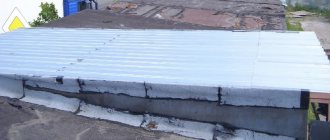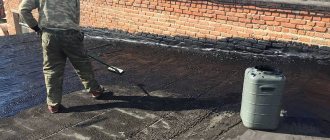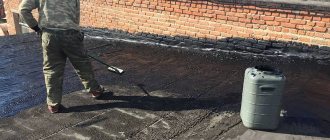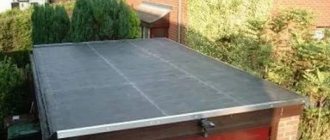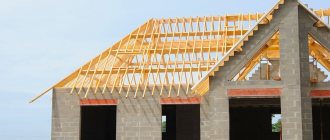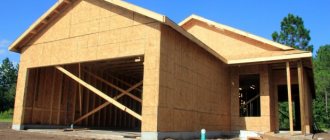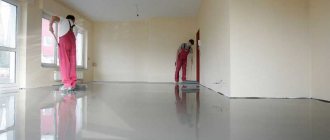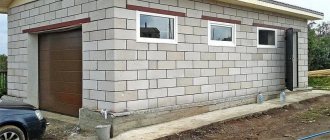Beton-House.com
Website about concrete: construction, characteristics, design. We combine the experience of professionals and private craftsmen in one place
When performing complex roof treatment, it is better to give preference to materials from one manufacturer.
In individual buildings, especially in the construction of auxiliary premises, a fairly popular material for the installation of floors is concrete: monolithic pouring into formwork or slabs. How to waterproof the roof of a concrete garage or outbuildings is carried out in this article.
Protecting the finishing floor from water is a very important point. The indoor climate, the service life of the ceiling itself and the building as a whole will depend on the correctness of the work. So, what materials can be used, how roofs are waterproofed, what is the procedure for carrying out the work and what mistakes should be avoided.
- Liquid waterproofing materials Bitumen mastic
- EPDM (ethylene propylene diene monomer) membranes
What is the best way to cover a garage roof?
A garage is a room, of course, not intended for housing, but it cannot perform all its functions if the roof constantly leaks.
Car owners especially often encounter this phenomenon in the spring, when the snow accumulated on the roof begins to melt. But a well-made roof will not leak or cause problems, and your car home will always be dry and cozy. What is the best way to cover the garage roof to avoid all the troubles? What is the best way to cover a garage roof?
Video description
All about the types and characteristics of soft roofs in the video:
Liquid roof
So, we continue to understand the question of how to cover the garage. And we move on to an amazing roofing material called “liquid rubber”. Essentially, it is a mastic that is applied in liquid form to a flat roof, and it polymerizes in air. The coating turns out to be very durable, but elastic, that is, it resembles rubber, hence the name.
Liquid roofing is divided into two groups:
- bitumen;
- polymer-bitumen.
The first one will last 15 years, the second 25. Their application technology is the same - using a spray bottle. The first group includes mastic brands: “Elomast”, “Gekopren”, BLEM-20 and others. The second is “Polykrov” with different fillings, for example, butyl rubber mastic or chlorosulfonate polyethylene.
Design Features
The purpose of any garage is protection from the external influences of a vehicle. Rain, snow, and wind can quickly ruin the appearance of a car, and for a motorcycle standing on the street, such effects are simply disastrous. Due to excess moisture, corrosion processes on metal products begin to occur quite quickly, destroying the metal. That is why the garage must be of high quality and have no leaks.
Garage roof repair
The roof on the garage can be single-pitch or gable. These are the most common options. In the first case, it is easiest to make a roof - it consists of one slope, resting on the walls of the building with different heights. The angle of inclination can be different (up to 60 degrees) - usually this indicator depends on the climate in the region, the wind rose, and the selected roofing covering.
Garage roof installation
Garage roof waterproofing
On a note! A roof with one slope is usually constructed if there is no need to create an attic.
The roofing material is laid on wooden rafters. The height of the difference is calculated by the formula H = D x tan a , where D is the width of the garage. The last indicator is selected according to the Bradis table. Wood for rafters must be treated with antiseptic compounds that will protect the material from the effects of biological organisms, and it is also recommended to coat it with compounds that reduce the likelihood of fire (fire retardants). The category of a pitched roof also includes roofing, which is often found on garages built of concrete.
Antiseptics for external wood treatment
A gable roof is built if the garage is planned to be equipped with an attic. Typically, such a roof has the shape of a triangle. The frame consists of rafter legs connected at a certain angle, supported by the walls and at the top point of their connection. The height of the roof ridge H and the length of the rafters C can be determined using the formulas H = 0.5 x H (Z: 2) and C = 0.5 x H/sin (Z: 2) , where Z is the slope value. For an equilateral roof, the appropriate option is to use the Pythagorean theorem.
Garage with gable roof
Less often, but still, a multi-slope roof is installed. However, it is already much more difficult to implement, so rarely does anyone undertake to build it with their own hands.
Advice! To create a roof on a garage with your own hands, beginners are advised to opt for a simple pitched roof.
Table. What else do you need to consider?
No. 6. Corrugated sheet
Another popular option for arranging a garage roof. Corrugated sheeting is a sheet of cold-rolled steel with a protective coating of zinc, aluminum or polymer. By giving the sheet a profile, it is possible to increase its strength qualities and at the same time improve its appearance. The profile can be in the form of waves or trapezoids, its height varies from 8 mm to 7.5 cm; sheets with a wave height of 35 mm or more are suitable for roofing work.
The protective coating is most often made of polyester, which well protects the steel sheet from corrosion, heat and frost, and mechanical damage. Acrylic and PVC coatings are cheaper and perform relatively well in operation. A good level of protection is provided by pural (polyurethane with the addition of polyamide and other substances). Zinc coating is the cheapest and is applied during the repair and restoration of sheets. For garages near the sea, busy highways or industries, you can take a profiled sheet with an aluminum-zinc coating, and for garages located in the northern regions - with plastisol protection.
pros:
- low cost;
- relative ease of installation;
- durability up to 50 years;
- resistance to fires and temperature changes;
- high strength - the metal sheet will withstand a person walking on the roof;
- corrosion resistance due to the use of protective coatings;
- wide range of colors.
Minuses:
- the metal gets very hot in the sun, so in the summer the garage will be like a bathhouse;
- The corrugated sheet makes a lot of noise when raindrops fall.
Both of these disadvantages can be minimized if the roof is properly insulated.
Installation of the profiled sheet is carried out on a 60*40 cm sheathing; the timber is pre-treated with an antiseptic. The sheets are secured using special self-tapping screws with rubber linings. The sheets are laid on top of each other with a slight overlap, the width of one wave. The corrugated sheets are fastened together with special rivets in the color of steel, and the space between the sheets is filled with sealant. You cannot fasten profiled sheets with ordinary nails - they will come off in a strong gust of wind.
A guide to covering a concrete garage roof
Concrete roofs are typically flat surfaces. Such roofs are economical, reliable and durable, and also have a long service life. Such garage roofs are made from monolithic casting or ready-made reinforced concrete slabs, which require appropriate coating in the future. You can read the instructions on how to cover a garage roof with bicrost here.
The picture shows a garage with a concrete roof.
What to cover with?
To the question of what is the best way to cover a garage roof made of concrete slabs, quite recently the answer was quite obvious - roofing felt. Since the technology for installing roofing felt sheets involves the use of mastic or roofing felt, the work is not very safe, and is also labor- and time-consuming. Currently, new and improved roofing materials with improved characteristics are appearing; accordingly, the use of roofing felt has begun to fade into the background.
A modern analogue of roofing felt is Bikrost, which is a roll-type soft roof. The installation process of this material is much simpler; it only requires the use of a gas burner to melt the adhesive layer, as well as a roller, a roofing mop and a primer, which is applied to the working surface of the roof before laying Bikrost. If we compare Birkost with roofing felt, the former is more flexible and has an increased service life.
The process of laying Bikrost on concrete and reinforced concrete roofs consists of several stages:
- Cleaning and leveling the working base;
- Application of a special primer for better adhesion of Bikrost to the roof surface;
- After the primer has completely dried, Bikrost is directly laid, which is rolled out across the surface across the slope of the roof;
- Overlaps at the ends must be at least 15 cm, and at the edges at least 10 cm;
- A gas burner is necessary to heat the Bikrost base, and then use a roller to roll out the material, gluing it to the roof surface.
How to make a concrete screed?
The phasing of work must be strictly observed:
- At the level of the top of the garage walls, floors are constructed from metal or wooden guides, which are laid horizontally. Next, floor elements are attached along the long walls and on top of the guides. Their length should be approximately 15 centimeters longer than the length of the garage on each side.
- Then the boards are laid end-to-end on the ceiling and additionally secured with guides on the outer sides of the garage walls.
- Sheets of roofing material are laid on top of the ceiling with an overlap of 10-15 cm to ensure good waterproofing.
- Insulation in the form of mineral wool or expanded clay is laid on top of the waterproofing.
- After laying the insulation, a screed made of a solution of cement and fine sand is applied on top.
- The screed is poured slowly, filling all voids and cracks. The surface of the screed is leveled using a wooden strip.
- The screed dries within a few days; only after complete drying is another layer of waterproofing and finishing coat applied.
How to pour concrete?
Look at the video for a clear example of how to fill a garage roof with concrete:
You can cover a concrete garage roof without a burner with roofing felt or waterproofing. Roll-type soft roofing is an excellent option for covering a concrete roof. In addition, you can use liquid rubber, which has recently become very popular. Read the guide on how to calculate the foundation for a garage on this page.
An excellent roof for a concrete or expanded clay concrete garage roof base would be Bikrost or Corrugated Sheet.
The ceiling for a garage roof made of foam concrete is usually made of a single slope. In addition, this roof option is the most common among garage construction.
How to lay a profiled sheet?
Covering a concrete roof with corrugated sheeting is quite simple. The necessary tools are a screwdriver, an electric jigsaw, a tape measure and a circular saw. Due to the small size of the garage, it is possible to use solid sheets of roofing material. With a standard profile sheet width of 1 meter and a garage length of 6 meters, 6 solid sheets will be needed for the roof. The first sheet of corrugated sheet is secured using a self-tapping screw at the top corner, then all subsequent sheets are secured. Instructions on how to make electrical wiring in a garage are here: https://kakgarazh.ru/osveshhenie/instrukciya-kak-sdelat-elektroprovodku-v-garazhe.html.
Experts do not recommend covering flat garage roofs, as moisture from precipitation will get under the roof. The corrugated sheet will serve as an excellent and reliable roofing for single- and double-pitched roofs. For better fastening of the profiled sheet on a concrete roof, you should first lay the boards, and then attach the roofing sheets to them using self-tapping screws. Read an overview of the characteristics of a garage slab foundation.
The photo shows the soft roof of a concrete garage roof
The picture shows a pitched garage roof covered with Profiled Sheet
Concrete roof covered with roofing felt
Roof insulation
Foam concrete is an effective insulation material. Thanks to its closed pores, foam concrete has low thermal conductivity, which makes it suitable for use as insulation, including for garage roofs. In addition, foam concrete is a lightweight material that is resistant to low temperatures and moisture.
Insulation of a concrete garage roof is usually done from the outside. The most commonly used material for such purposes is polystyrene foam with increased strength characteristics.
Roof repair
If the roof of a garage leaks through the concrete, it means that significant mistakes were made during construction. Or the roof has become unusable after a long period of use. In this case, the roof will have to be dismantled and hydro- and thermal insulation done again. If the top waterproofing layer is damaged, it is enough to simply repair the problem areas using liquid rubber or Bikrost. Read the instructions on how to choose a foundation for a garage and how to build it.
Where to order garage roof repair services in Moscow?
- Repair - Garages.
contact number
As you can see, a concrete roof for a garage is a strong and durable foundation. If you follow the exact technology of its construction, it will practically not cause problems in the future. In addition, almost any roofing covering can be laid on a concrete roof.
No. 1. Ruberoid
The cheapest way to organize a garage roof. Roofing felt is produced on the basis of roofing cardboard, which is impregnated with bitumen and protected with asbestos coating, which increases resistance to moisture, sunlight and mechanical loads.
Advantages of the material:
- cheapness;
- high degree of waterproofing;
- good for protecting hard-to-reach places;
- in the presence of special polymer additives, resistance to sunlight and temperature changes increases (these are the weak points of roofing material).
Main disadvantages :
- low durability. Within a few years after installation, there will be a lot of cracks on the roofing felt, so leaks are possible, and there is no need to talk about reliable protection of the garage;
- sensitivity to high temperatures (roofing material softens greatly) and low temperatures (becomes brittle);
- fire hazard.
In new types of roofing felt with modifying additives, some disadvantages were significantly reduced, which is why the material is consistently in demand. Experts call roofing felt more likely an option for waterproofing than for roofing.
Ruberoid is excellent for single-pitch, almost flat (slope up to 5 degrees) roofs. On the concrete base of the roof, a screed is first performed, creating a slight slope for better precipitation. For the screed, formwork is formed from boards; it is better to pour concrete at once. After 3-4 days, you can remove the formwork, and when the concrete has set well (15-20 days), you can begin installing roofing felt . Briefly the process looks like this:
- the screed is cleared of debris (swept up);
- the screed is covered with bitumen mastic, which will improve waterproofing;
- proceed to the installation of roofing felt, which is laid in strips in a direction transverse to the angle of inclination, the base is lubricated with concrete mastic, the bottom layer of bitumen is heated with a gas burner. The overlap of the sheets is 10-15 cm, installation begins from the bottom of the roof. After this, the roofing material is mounted in a perpendicular direction, coating it with bitumen;
- You can lay roofing felt in three layers, then the first is done in the longitudinal direction to the slope of the roof, the second - in the transverse direction, the third - again in the longitudinal direction. The bottom layer can be made not with roofing, but with lining roofing material.
Self-propelling and bulk roofing felt are also on sale.
How to cover a concrete garage roof?
Although a garage is a non-residential premises, it is a mistake to neglect the covering of such a structure. If the coating is not strong enough or has cracks, you risk getting mold, which especially loves moisture. The garage roof is covered in the same way as any other residential space, that is, it is thermal insulation, waterproofing, and protection from various damages. The materials used to cover a garage are the same as when covering another type of building. There are a number of nuances here that can significantly affect the quality of the coating, its performance, strength and durability.
The roof of a garage can be covered with any material, but recently concrete has gained popularity. It is considered good because of its durability - a minimum of 15 years and above. Another good thing about such a roof is that you can install it yourself (of course, if you have the necessary equipment). These are the most important advantages of a concrete ceiling.
No. 2. Rubemast
This is an improved type of roofing felt . It is also based on thick construction cardboard (although fiberglass can also be used), which is impregnated with bitumen on both sides. There is much more of the latter than in roofing felt, which ensures higher ductility, waterproofing and resistance to cracks. Powder is used for additional protection. The bottom layer is a polymer film designed to be melted by a burner during installation.
Advantages:
- low price;
- relative ease of installation;
- excellent waterproofing properties;
- resistance to heat and precipitation;
- durability up to 15 years.
Minuses:
- cannot withstand even light loads. If a person weighing more than 50 kg walks on the coating, then the appearance of cracks is inevitable;
- the base must be level, otherwise cracks may occur during operation;
- under constant exposure to direct sunlight, microcracks appear after 1.5-2 years.
Installation can be carried out using bitumen mastic (as in the option described above for roofing felt) or using a gas burner. If the installation work is carried out correctly, then the problem of roof leaks in the garage will not affect you for a long time.
Selection of materials and characteristics
Before choosing a concrete roof covering, you need to consider the following factors:
- Efficiency - to put it simply, you will need to think about how much the roof can protect from humidity and cold. This is one of the most important factors when it comes to choosing a roof.
- The complexity of installation - in this case, the building can be covered with two types of materials: those that you can lay yourself, as well as those that require professionals to install. Usually the first option includes cheap types of coatings. If you choose the second option, you will most likely need outside help.
- Harmonious fit into the environment also plays an important role. Especially if the garage is located next to a residential building, you should seriously think about its design - it is advisable that the roof be made of the same covering as the house itself.
Return to contents
No. 7. Metal tiles
Metal tiles, just like corrugated sheets, are made from galvanized steel sheets, only they are given not just a wave profile, but imitate the profile of natural tiles. A phosphate layer (additional protection), a primer and a polymer-decorative coating are applied over the protective zinc layer. A protective transparent varnish is applied to the back side. The greater the thickness of the sheet, the stronger the coating: for roofing it is better to take material with a thickness of at least 0.5 mm. Performance properties strongly depend on the type of protective polymer coating. The coating made of pural and plastisol has proven itself best. Matte and glossy polyester are cheaper, but if the installation technique is followed, they can also provide reliable protection.
pros:
- light weight, which simplifies installation and reduces the load on the foundation and rafter system;
- resistance to low and high temperatures, high humidity due to the protective coating. It also ensures free drainage of precipitation from the roof surface;
- relative ease of installation;
- excellent decorative qualities, wide range of colors;
- the material does not support combustion;
- relatively low cost.
Minuses:
- loss of a significant part of the performance qualities when the protective coating is damaged;
- difficulties when arranging a roof of a non-standard shape, but garages are usually built with fairly simple roofs, so this cannot be considered a minus in our case;
- heating in the sun and noise during rain, but with proper sound insulation, this disadvantage can be easily eliminated.
Metal tiles can be used on roofs with a slope angle of more than 15 degrees, otherwise snow removal will be complicated due to the topography of the coating. The material is often used when the garage is located on the same site as the house, so that all buildings have the same type of roof.
Bituminous shingles
Bituminous, or as it is also called flexible, tiles are a popular, reliable covering for the roofs of garages and residential buildings. Although such a roof is indeed durable, there are many factors to consider, especially at what angle it is installed. Often, if the roof does not reach a certain angle, the roof may leak, to prevent this from happening, there will be costs for additional coverage. The disadvantage of this roof is the poor tolerance of the tiles to low temperatures - they become brittle, and at high temperatures there is a risk of a slight melting.
No. 4. Slate
Asbestos-cement wave slate is a coating that is well known to everyone and is widely used in the arrangement of garages. The material is based on Portland cement, asbestos and water, while asbestos plays the role of a reinforcement cage, providing the slate with the necessary strength. The typical color is grey, but slate can be painted if desired to enhance its aesthetic appeal and level of protection.
Advantages:
- relatively little heating in sunny weather (when compared with roofing felt or metal coatings);
- high strength - an adult can walk on the roof without breaking a sheet of slate, which is important if necessary to carry out repair work;
- fire resistance, no release of toxic substances during combustion;
- good sound insulation. When it rains heavily outside, the inside of the garage will be almost silent;
- corrosion resistance;
- low price;
- durability up to 25 years.
It would seem that the ideal roofing material for the garage has been found, but that was not the case. Among the disadvantages of slate it is worth noting:
- the carcinogenicity of asbestos, which is part of the slate, therefore it is better to take chrysolite cement sheets;
- the high weight and fragility of the material significantly complicate installation;
- low resistance to temperature changes;
- under the influence of high temperatures, although slate does not burn, it cracks with the formation of sparks.
And even despite these shortcomings and the abundance of other materials, slate remains almost the most popular material for garage roofing.
Sheets of slate are placed on the sheathing, placing one sheet on top of another with an overlap of 20 cm. For fastening, special nails with an enlarged head are used; they are not driven in tightly, but leave a gap of 2-3 mm to avoid the appearance of cracks on the slate. In order not to deform the slate, it is better to pre-drill holes in it for nails. However, it is almost impossible to completely avoid cracks during installation, so upon completion of installation, the cracks are covered with a solution prepared from cement, PVA glue, asbestos and water in a ratio of 2:1:3:1.
Use of sheet materials
If we talk about slate, it is durable, resistant to temperature changes, and it is easy to repair (you just need to replace damaged sheets). With a large number of advantages, there are disadvantages: fragility, instability to moisture, heavy weight of the sheets.
Metal tiles are similar in appearance, they look like ordinary tiles, but are made of iron, copper, aluminum. This material is relatively inexpensive, weighs little (especially compared to slate), is characterized by relative durability, resistance to external factors, and beautiful appearance.
Colored polymer slate.
The disadvantage is the lack of sound insulation - if it rains or hails, the noise level will increase. As an additional bonus when covering, a roof covered with such material looks beautiful. Polymer slate is one of the inexpensive coatings. It has less durability than slate, has high strength and stability, and weighs much less than slate. Like regular slate, it is laid in slabs, but it is not as fragile.
For greater comfort and convenience, you should think about roof insulation. This will help save on additional heating equipment, plus make the building much warmer. It is worth understanding the insulation materials that can be installed under the roof.
No. 3. Linocrom
Linocrom is a modern rolled material with a fiberglass base, which is treated with bitumen and protected with powder and polymer film.
Advantages:
- ease of installation;
- resistance to temperature changes;
- low weight;
- maintainability. If any part of the coating is damaged, then it is enough to simply fuse new material onto the desired area;
- tensile strength - the material can withstand significant loads;
- durability up to 10 years.
Flaws:
- the top layer is poorly resistant to aggressive substances;
- the material is only suitable for low pitched roofs;
- installation with construction tape is not suitable - the seams in this case will be a weak point.
Installation of linochrome is carried out in dry, windless weather, having previously cleaned the roof surface. The bottom layer is heated with a blowtorch or torch, and rolls of material are laid overlapping.
Tips for choosing materials
When choosing a coating for a concrete roof, special attention should be paid to strength and durability. The greater these indicators, the longer the material will last. It is a mistake to think only about price and choose the cheapest. As often happens, the stingy pays twice - who knows how much it will cost to repair a roof made of cheap material.
It is worth paying attention to the appearance of the materials themselves: they should look suitable for use. By the way, service life is another important factor when choosing from a variety of materials - the longer the service life, the better. Be sure to ask the seller about resistance to temperature changes, the level of moisture and various noise transmission, and the level of susceptibility to defects. The garage should also be insulated to ensure dryness.
When choosing insulation, you should give preference to natural materials. Of course, synthetic ones are much cheaper, but they are highly flammable, and when burned they can release toxic gas such as phenol into the air. Natural insulation is considered the best choice.
No. 5. Ondulin
Externally, ondulin resembles slate. It is also sold in the form of corrugated sheets, but they are produced on the basis of cellulose fibers, which are mixed with minerals, impregnated with bitumen, resins and special additives. From above (and sometimes both above and below) ondulin is painted in one of many shades. Due to impregnation with bitumen and other protective substances, the material receives solid resistance to external adverse influences, and painting allows you to obtain an aesthetic coating, and all this at a relatively low cost.
pros:
- moisture resistance. According to this indicator, ondulin outperforms almost all other roofing materials. Over time, cellulose fibers become even stronger when exposed to sunlight, providing an even higher level of moisture resistance;
- light weight. An ondulin sheet is 4 times lighter than a slate sheet with the same dimensions, therefore it is much easier to transport and install the material;
- corrosion resistance;
- sound insulation - the sound of raindrops on the roof will not block out all other sounds in the room;
- ease of processing. Using a hacksaw for wood, sheets are easy to cut, and thanks to the flexibility of the material, it can be given a complex shape, which will come in handy if the roof has a non-standard shape;
- low cost.
Minuses:
- fading due to sunlight;
- flammability. Already at a temperature of +2500C, ondulin begins to burn;
- an unpleasant odor may appear in the summer heat;
- brittleness at low temperatures;
- low strength is usually associated with a violation of installation technology. If you fasten each sheet with 20 nails and make the sheathing in increments of at least 0.6 m, then you will not have any problems. However, in the heat, when the bitumen impregnation softens, it is better not to walk on the roof.
The durability of the material is 15-20 years, subject to proper installation and operation.
Ondulin is attached to a crate made of wooden beams, and the beams must be strictly parallel to each other. It is most convenient to cut sheets of ondulin while still on the ground. Installation work is carried out at above-zero temperatures; ondulin sheets are attached to special hardware with wide caps.
Garage roof waterproofing
Waterproofing is one of the important components of coating installation. The roof cannot be considered serviceable and complete without such a part. It is this that helps prevent moisture that collects on the roof from getting inside. Waterproofing is usually installed in two ways: laying a special film and building a special sheathing on top of it, or laying the material using sealed tape with the construction of a special frame.
Waterproofing is carried out mainly from two materials - roofing felt and water barrier. Ruberoid has long won the hearts of builders and owners of buildings - it is easy to install, but this is where its main advantages end. It is less durable compared to other materials, and can break under a certain load, plus it has a short service life. Compared to roofing felt, a hydrobarrier is much more effective. Of course, you will need to tinker with it a lot longer; each part and type of roof has its own rules, but its strength and stability are worth it.
Concrete roofing is one of the most common roofs used in garage construction. When choosing the type of roof, you should definitely pay attention to the natural conditions in which the garage is located. When choosing materials for roof covering, you should not give preference to cheap ones, because they are not strong and durable, and after a while you will need to make repairs.
When installing waterproofing on concrete roofs, you should not choose a cheap option, and if independent installation is not possible, you should call a team of craftsmen. And remember that a garage with a concrete roof will last much longer than one covered with other materials.
Extruded polystyrene foam
Roof insulation with extruded polystyrene.
Extruded polystyrene foam is a synthetic insulation material invented in the last century. This material withstands moisture well, temperature changes, withstands various types of deformation, is resistant to solvents, can withstand high or low temperatures, is characterized by durability, but it also has a significant disadvantage: it has a high fire hazard due to its synthetic composition.
Return to contents
Traditional insulation scheme
With the traditional roof insulation scheme, the main layer of waterproofing protects the insulation from the effects of atmospheric moisture.
Pie device
The garage is covered with a roofing “pie” having the following layers:
- concrete floor slabs;
- leveling cement screed;
- vapor barrier;
- layer of insulating material;
- waterproofing;
- roofing material.
Waterproofing
As waterproofing for a garage roof, roofing felt laid in several layers or specialized roll materials can be used. A prerequisite is the fastening of waterproofing materials using mastic or liquid bitumen.
Using the fusing method using open fire is unacceptable, because there is a risk of fire.
Coating
When choosing the best way to cover a garage roof made of concrete slabs, you should pay attention to the following materials:
- flexible bitumen shingles;
- rolled materials;
- sheet materials (slate, metal tiles, polymer slate).
In some cases, the garage is designed for the active use of the roof. In this case, the roof can be paved with paving slabs or paving stones.
The thermal insulation layer can be made of any material suitable for its physical characteristics (mineral wool, EPS, bulk mineral insulation).
Principles of thermal insulation
The garage, or rather its roof, is insulated according to the same laws and principles that apply when insulating the walls of residential buildings:
- the thermal insulation layer must be located outside;
- waterproofing should protect concrete floor slabs and, if necessary, insulation;
- conditions must be created to prevent mechanical damage to the layers of hydro- and thermal insulation.
The last condition is especially relevant in cases where the roof is in use (which is quite common).
The thickness of the thermal insulation layer that needs to cover the roof is selected in each case separately. It depends on the mode in which the garage is operated, the climatic characteristics of the area and the thermal characteristics of the insulation itself.
Construction of houses
When building a garage, after the walls have been erected, the question arises of how to properly build the roof. The quality of this design depends on the correct selection of its dimensions and the material used. Before you start building a roof, pay special attention to how to choose the right material to cover your garage roof.
Content:
Types of garage roofs
The design of the roofs is quite simple if they are garage roofs. Typically, the roofs of adjacent car shelters are made in a single-pitch version, and for prefabricated garages - in a flat version. Among single-standing garages, gable roofs predominate. In this version, the roof has a large attic and is beautiful from an architectural standpoint.
Shed roof
A pitched roof in our time will be the simplest design for a garage. Its entire weight always falls on the walls of the building. This roof is made with different angles of inclination. The size of the angle will depend entirely on the material used and the region in which the construction is being carried out.
A pitched roof is erected in cases where you do not need an attic space. The slope angle can vary from 0 to 60 degrees. It is not recommended to exceed it. When laying the roofing covering, it is recommended to take into account the minimum slope that is permissible for it, depending on the physico-chemical properties of the material.
The main component of a pitched roof is the rafters. They most often consist of beams made from pine needles. The wood must be dried and before that treated with an antiseptic. This procedure makes it possible to protect the tree from pests and bad weather, as shown in the video about covering the roof of a garage. For shed roofs, the rafters are always sloping.
Gable roof
If you need an attic above the garage to store your things, then the roof is made with a gable roof. A popular design for such an attic is an equilateral triangle. A gable roof is not difficult to install. The frame consists of two rafters of equal sizes. They are laid sequentially. After this, at the highest point they are connected into a “ridge”.
The roof is supported by the walls of the garage. In order to correctly calculate the required dimensions of the rafters and ridge, you need to know exactly the dimensions of the garage and the angle of the roof. To neaten the canopy of the future roof, it is necessary to add approximately 30 - 50 cm to the length of the rafters.
The installation of a gable roof begins with the frame. It is assembled in parts. A mauerlat is laid around the perimeter, which is attached to the wall with anchors. A roofing material layer is laid between the wall (made of concrete or brick masonry) and the mauerlat.
Covering the garage roof with roofing material
Building a garage roof with your own hands consists of several stages: erecting a rafter system, carrying out waterproofing, laying the selected material according to the garage roof covering scheme, arranging thermal insulation, laying a vapor barrier, cladding from the inside. When building a garage roof without an insulation system, the work is much simpler. But at the same time, the storage conditions for the car in winter become much worse. Therefore, a roof without insulation does not provide a full opportunity to heat the garage.
Preparing the garage roof
When covering a garage roof with your own hands, like other roofing and construction work, you should start with careful preparation of the surface:
- All work related to the roof is carried out in good sunny weather. For these purposes, it is necessary to look at the weather forecast for at least a week in advance, since such work will not be carried out for one day.
- When preparing the concrete floor for roofing work, it must be cleared of the old coating. Cleaning must be done thoroughly down to the base of the concrete. It is forbidden to lay new material on top of the old one. If the old layer has become unusable, then it will not be able to help the new one. Also, when laying a new layer on top of an old layer, uneven laying will occur, so you will still have to clean off the old layer.
- To clean the roof from unusable old covering, prepare the following tools: a knife, a chisel and an axe. All of them must be well sharpened. Using an ax, notches are made across the entire area of the roof; they can be directed in any direction. After this procedure, the roofing material is removed by tearing it off with a knife. In more difficult places, use a chisel.
- Quite often, the roof leaks in several places. To eliminate such defects, it is necessary to seal all formed cracks. The method of sealing depends on their size. Small cracks are sealed with liquid glass. Wider ones - with polyurethane foam. Before sealing the gap, it is treated with a dampened brush. After you have foamed the cracks according to the instructions, you need to wait a while for the material to harden. Next, cut off the excess with a knife. The cracks are also sealed with cement-sand mortar. You can also use roofing mastic and special glue.
- Usually the slab is destroyed along its edges. This part of the slab must also be repaired by cleaning it from dust and chips. Next, we treat the cleaned slab with a special primer. After the slab has dried, we carry out restoration work using cement-sand mortars.
- When preparing a slab for repair, you need to pay attention to the quality of the entire surface. If there are obvious irregularities, then they need to be eliminated. The base of the slab should be level, or even better if it is smooth, as in the photo of the garage roof covering. For this purpose, it is necessary to fill the depressions with cement mortar, and remove the bulges using a chisel.
- Next, remove dirt and dust from the treated surface using a broom. Then they are treated with a primer. Protruding areas of reinforcement from the slab are treated with special phosphoric acid. This procedure will prevent the development of corrosion.
- If the laid slab does not have even a minimum slope of 3-5 degrees, this must be corrected by applying a layer of cement screed.
Types of coatings
Depending on the form of release, roll, sheet and small-piece materials are distinguished. Different types differ in the ways in which a garage can be covered. When making a choice, it is recommended to familiarize yourself with the main parameters of each variety.
Rolled
Rolled materials are optimal for covering flat roofs. They can be laid on the roof without first constructing a sheathing. Due to their tight fit to the base, roll coverings provide high hydro- and noise insulation.
Leafy
This type of sheet roofing is suitable for large scale roofs. Sheet materials are made from cement fiber or asbestos cement. The main advantages of sheet coverings include:
- chemical inertness;
- long period of operation;
- strength;
- affordable price.
Disadvantages include fragility, low decorative characteristics, heavy weight, and discoloration when exposed to moisture.
How to choose a slope angle
The appearance of the building depends not only on the selected garage roof covering material. For different purposes and needs, there are several types of structures, on which the appearance of the building depends.
For example, flat roofs are convenient in cooperatives because they allow buildings to be located closely. It is supported by walls, and the base consists of slabs or screeds. Such structures are covered with a material that is impervious to temperature changes.
On the plus side, you can use the surface for personal use, creating a hanging garden or sunbathing area.
The pitched type of structure is a superstructure that is installed at an angle of 10⁰-60⁰. There are several pitched structures:
- Shed, when one of the supporting walls is made higher, creating the required slope. A simple and inexpensive type of coating.
- Gable. The design consists of two planes resting on beams. Its main advantage is the ability to arrange an attic.
- Attic. This roof has 4 or 6 roof slopes. It is expected that engineering systems will be developed to support the structure. It is complex and expensive, but has the advantage of having a room under a roof.
- Tent. A typical type of structure, used to maintain the overall architectural style, consists of four slopes of the same size. The masonry is done not on two sides, as in the case of gable and mansard roofs, but on four.
The gable type of construction is considered the most reliable and easiest to implement.
